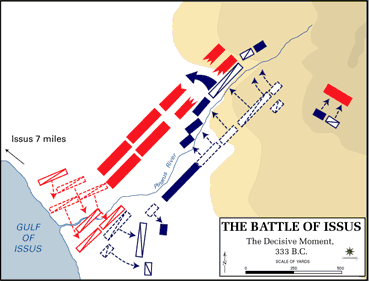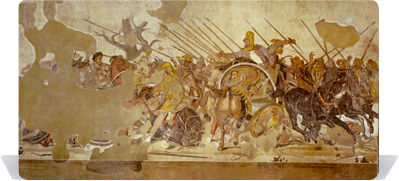The Battle of Issus
In the year 333 BC, Alexander the Great and King Darius III crossed swords for the first time. The official war objective of Macedonia was revenge. Revenge on the Persians for the destructive campaign against Greece, which had taken place 150 years previously. Unofficially, but entirely openly, Alexander was using the campaign in his quest for fame and conquest. Before the battle, however, Alexander suffered for eight weeks with a fever and was cared for by the family doctor. He sent Parmenion, his commander of infantry and the Peloponnesian cavalry, on ahead. He rode with 15,000 men to the Syrian border to block off access to the Persians. During this period, Memnon, Darius’s prized general, died from a severe illness, with the result that the King had to call up the council of war, whereupon he decided to engage Alexander in open combat.
Alexander moved with his army first to Issus and then further along the coast road. He expected to meet with the enemy at some point here. Darius also wanted to meet him on this plain near Issus, which appeared favourable to him. Instead he was forced to continue marching with his army along an easterly road to the city of Issus, leaving behind the favourable plain, as he was unable to support his army permanently at that place. This meant that both armies marched past each other in parallel, separated by a mountain range.
Darius had heard from the wounded Greek soldiers left behind there that Alexander had taken the coast road with his army. Now the king followed him with his army. When Alexander in turn found out that the enemy was to his back, he ordered his army to return quickly to Issus.

The battlefield, on the plains of Issus, was bordered on one side by the mountain range and by the Mediterranean on the other. The numerical superiority of the Persians was therefore considerably limited. There are many estimates as to the numbers in the Persian army, but it is accepted that it was a maximum of 100,000 men strong. On the Persian side, the heavy cavalry positioned itself on the right wing near the coast. The flat plains were extremely favourable to the cavalry. Heavily-armed Greek soldiers arrived in the middle. To the left were the Kardaks (Iranian infantry), and the left mountain slope was occupied by lightly-armed units. Darius III positioned himself with his chariot and mounted guard behind the middle of the front. His plan was to tip the balance with the heavy cavalry on the right wing. Alexander’s right flank would be captured with it, together with the Hetairoi cavalry. The centre was formed by the Macedonian phalanx. Peloponnesian horsemen, under the control of Permenion, formed the left flank on the coast. Shortly before the start of the battle Alexander ordered the Thessalian cavalry, who were positioned on the right, to go over to Parmenion on the left flank, so that this would be strengthened against the Persian mounted attack. His tactic was to pin down the enemy with the Macedonian infantry and to tear open gaps. The gaps would provide an opportunity for a mounted attack on the Persian centre.
During the battle, the Macedonian phalanx had problems asserting itself against the Greek Hoplites. Parmenion’s left flank was also penetrated. But the chance presented itself at the right moment. A gap appeared in the front and, despite bitter resistance from the Persian infantry, Alexander fought through to the head to King Darius. Darius recognised the danger of encirclement, turned his chariot and fled from the battlefield, although the battle was far from over. The phalanx had to traverse the Pinaros river, with its strong currents, which in turn tore large gaps in their ranks. Darius’s Greek soldiers took advantage of this and caused significant losses to the approaching phalanx. On the coastal side, the Persian cavalry continued to strongly harry the Greek infantry and the Peloponnesian horsemen. Using crescent-shaped pivot movements, Alexander’s cavalry helped the embattled Greeks in their critical position. He also attacked the flanks of the enemy centre. Dispirited by the flight of the king, the Persian army retreated with all its soldiers. The number of dead on the side of Alexander the Great is put at 450 men, with approximately ten times that number wounded. There were thousands of times more dead and injured on the side of the Persian army. Darius had to leave his mother and wife behind following his flight. Unexpectedly, Alexander treated them as queens and even allowed them to acknowledge such honours. Also among the prisoners were Persian nobility, such as Barsine, who Alexander later married. In addition, 3,000 talents in cash and the entire treasury in Damascus were looted, which was sufficient to pay all outstanding soldiers’ pay owed by Alexander and to pay the army for another whole year.
Youtube-Link: Battle of Issus, 5 parts (english) Source of the picture "The Battle of Issus"